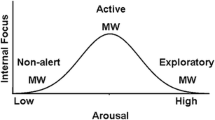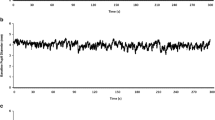Abstract
Although the eyes and the heart serve very different purposes, each receives autonomic innervation. Capitalizing on recent theoretical and technological innovations in the understanding and assessment of oculomotor and cardiovascular behavior, three experiments measured behavioral covariation between the oculomotor and cardiovascular systems. Measures of dark focus and dark vergence indexed oculomotor tone, and the spectral decomposition of variations in heart rate indexed cardiovascular control mechanisms. In Experiment 1, individual differences in cardiovascular parameters could predict individuals’ dark vergence (R2=.806) but not their dark focus (R2=.404). In Experiment 2, the same parameters were measured from subjects who experience either panic attacks (n=11) or blood phobia (n=9). Heart rate was positively correlated with dark vergence and the two subject groups were separable based on both oculomotor and cardiovascular variables. Using a within-subjects approach, Experiment 3 found that both dark vergence and dark focus tended to be nearer during sympathetic dominance of the heart than during parasympathetic dominance, within-subjects variations in cardiovascular parameters could predict dark focus, and between-subjects variations in interbeat intervals could predict dark vergence. Shared patterns of autonomic activation may be responsible for this eye-heart link.
Similar content being viewed by others
References
Akselrod, S., Gordon, D., Ubel, F.A., Shannon, D.C., Barger, A.C., & Cohen, R.J. (1981). Power spectrum analysis of heart rate fluctuation: A quantitative probe of beat-to-beat cardiovascular control.Science, 213, 220–222.
Alexander, J.P. (1975). Reflex disturbances of cardiac rhythm during ophthalmic surgery.British Journal of Ophthalmology, 59, 518–524.
Blanc, V.F., Hardy, J., Milot, J., & Jacob, J. (1983). The oculocardiac reflex: A graphical and statistical analysis in infants and children.Canadian Anaesthesia Society Journal, 30, 360–369.
Brick, I. (1966). Circulatory responses to immersing the face in water.Journal of Applied Physiology, 21, 33–36.
Cerutti, S., Gortis, G., Liberati, D., Baselli, G., & Civardi, S. (1988). Power spectrum analysis of heart rate variability during a mental arithmetic task.Journal of Ambulatory Monitoring, 50, 38–47.
Cogan, D.G. (1937). Accommodation and the autonomic nervous system.Archives of Ophthalmology, 18, 739–766.
Colombo, R., Mazzuero, G., Soffiatino, F., Ardizzoia, M., & Minuco, G. (1990). A comprehensive PC solution to heart rate variability analysis in mental stress.1989 IEEE Computers in Cardiology, 475–478.
Duda, R.O., & Hart, P.E. (1973).Pattern Classification and Scene Analysis. New York: Wiley.
Eakins, K.E., & Katz, R. (1971). The pharmacology of extraocular muscle. In P. Bach-y-Rita, C.C. Collins, & J.E. Hyde (Eds),The Control of Eye Movements (pp. 237–258). New York: Academic Press.
Eakins, K.E., & Katz, R.L. (1967). The effects of sympathetic stimulation and epinephrine on the superior rectus muscle of the cat.Journal of Pharmacology and Experimental Therapeutics, 157, 524–531.
Ebenholtz, S.M., Cohen, M.M., & Linder, B.J. (in press). The possible role of nystagmus in motion sickness: An hypothesis.Aviation, Space, and Environmental Medicine.
Epstein, S., & O’Brien, E.J. (1985). The person-situation debate in historical and current perspective.Psychological Bulletin, 98, 513–537.
Friedman, H. (1968). Magnitude of experimental effect and a table for its rapid determination.Psychological Bulletin, 70, 245–251.
Friedman, B.H., Thayer, J.F., Borkovec, T.D., Tyrrell, R.A., Johnsen, B., & Colombo, R. (1993). Autonomic characteristics of nonclinical panic and blood phobia.Biological Psychiatry, 34, 298–310.
Gandevia, S.C., McCloskey, D.I., & Potter, E.K. (1978). Reflex bradycardia occurring in response to diving, nasopharyngeal stimulation and ocular pressure, and its modification by respiration and swallowing.Journal of Physiology, 276, 383–394.
Gawron, V.J. (1983). Ocular accommodation, personality, and autonomic balance.American Journal of Optometry & Physiological Optics, 60, 630–639.
Gilmartin, B. (1986). A review of the role of sympathetic innervation of the ciliary muscle in ocular accommodation.Ophthalmic & Physiological Optics, 6, 23–37.
Gilmartin, B., Hogan, R.E., & Thompson, S.M. (1984). The effect of timolol maleate on tonic accommodation, tonic vergence, and pupil diameter.Investigative Ophthalmology & Visual Science, 25, 763–770.
Grossman, P., Karemaker, J., & Wieling, W. (1991). Prediction of tonic cardiac parasympathetic control using respiratory sinus arrythmia: The need for respiratory control.Psychophysiology, 28, 201–216.
Huberty, C.J. (1984). Issues in the use and interpretation of discriminant analysis.Psychological Bulletin, 95, 156–171.
Hundleby, J.D., Pawlik, K., & Cattell, R.B. (1965).Personality factors in objective test devices: A critical integration of a quarter of a century’s research. San Diego, CA: Robert R. Knapp.
Jaschinski-Kruza, W. (1991). Eyestrain in VDU users: Viewing distance and the resting position of ocular muscles.Human Factors, 33, 69–83.
Johnson, R.A., & Wichern, D.W. (1988).Applied multivariate statistical analysis (2nd ed). Englewood Cliffs, New Jersey: Prentice-Hall, Inc.
Kawakami, Y., Natelson, B.H., & DuBois, A.B. (1967). Cardiovascular effects of face immersion and factors affecting diving reflex in man.Journal of Applied Physiology, 23, 964–970.
Khurana, R.K., Watabiki, S., Hebel, J.R., Toro, R., & Nelson, E. (1980). Cold face test in the assessment of trigeminal-brainstem-vagal function in humans.Annals of Neurology, 7, 144–149.
Kleiger, R.E., Miller, J.P., Bigger, J.T., Moss, A.J., & The Multicenter Post-Infarction Research Group (1987). Decreased heart rate variability and its association with increased mortality after acute myocardial infarction.American Journal of Cardiology, 59, 256–262.
Leibowitz, H.W. (1976). Visual perception and stress. In G. Borg (Ed.),Physical Work and Effort (pp. 25–37). Oxford: Pergamon.
Leibowitz, H.W., & Owens, D.A. (1975a). Anomalous myopias and the intermediate dark focus of accommodation.Science, 189, 646–648.
Leibowitz, H.W., & Owens, D.A. (1975b). Night myopia and the intermediate dark focus of accommodation.Journal of the Optical Society of America, 65, 1121–1128.
Levy, M.N., & Zieske, H. (1969). Autonomic control of cardiac pacemaker activity and atrioventricular transmission.Journal of Applied Physiology, 27, 465–470.
Mallinson, F.B., & Coombes, S.K. (1960). A hazard of anaesthesia in ophthalmic surgery.The Lancet, 1, 574–575.
Manuck, S.B. (1994). Cardiovascular reactivity in cardiovascular disease: “Once more unto the breach.”International Journal of Behavioral Medicine, 1, 4–31.
Martin, G.J., Magid, N.M., Myers, G., Barnett, P.S., Schaad, J.W., Weiss, J.S., Lesch, M., & Singer, D.H. (1987). Heart rate variability and sudden death secondary to coronary artery disease during ambulatory electrocardiographic monitoring.American Journal of Cardiology, 60, 86–89.
McBrien, N.A., & Millodot, M. (1985). Clinical evaluation of the Canon Autoref R-1.American Journal of Optometry & Physiological Optics, 62, 786–792.
Michelson, L., Marchione, K., Greenwald, M., Glanz, L., Testa, S., & Marchione, N. (1990). Panic disorder: Cognitive-behavioral treatment.Behaviour Research & Therapy, 28, 141–151.
Miller, R.J. (1978). Mood changes and the dark focus of accommodation.Perception & Psychophysics, 24, 437–443.
Miller, R.J. (1987). Nonius alignment apparatus for measuring vergence.American Journal of Optometry & Physiological Optics, 64, 458–466.
Miller, R.J., & LeBeau, R.C. (1982). Induced stress, situationally-specific trait anxiety, and dark focus.Psychophysiology, 19, 260–265.
Miller, R.J., & Takahama, M. (1988). Arousal-related changes in dark focus accommodation and dark vergence.Investigative Ophthalmology & Visual Science, 29, 1168–1178.
Miller, R.M., & Takahama, M. (1987). Effects of relaxation and aversive visual stimulation on dark focus accommodation.Ophthalmic & Physiological Optics, 7, 219–223.
Miller, S.B. (1993). Cardiovascular reactivity in anger-defensive individuals: The influence of task demands.Psychosomatic Medicine, 55, 78–85.
Nesselroade, J.R. (1990). The warp and the woof of the developmental fabric. In R. Downs, L. Liben, & D.S. Palermo (Eds.),Visions of development, the environment, and aesthetics: The legacy of Joachim F. Wohlwill. Hillsdale, NJ: Lawrence Erlbaum Associates.
Neter, J., Wasserman, W., & Kutner, M.H. (1985).Applied linear statistical models (2nd Ed. ed.). Homewood, IL: Irwin.
Owens, D.A. (1979). The Mandlebaum effect: Evidence for an accommodative bias toward intermediate viewing distances.Journal of the Optical Society of America, 69, 646–652.
Owens, D.A. (1984). The resting state of the eyes.American Scientist, 72, 378–387.
Owens, D.A. (1987). Oculomotor information and perception of three-dimensional space. In H. Heuer & A.F. Sanders (Eds.),Perspectives on Perception and Action (pp. 215–248). Hillsdale, New Jersey: Erlbaum.
Owens, D.A., & Leibowitz, H.W. (1976). Oculomotor adjustments in darkness and the specific distance tendency.Perception and Psychophysics, 20, 2–9.
Owens, D.A., & Leibowitz, H.W. (1980). Accommodation, convergence, and distance perception in low illumination.American Journal of Optometry and Physiological Optics, 57, 540–550.
Owens, D.A., & Leibowitz, H.W. (1983). Perceptual and motor consequences of tonic vergence. In C.M. Schor & K.J. Cuiffreda (Eds.),Vergence eye movements: Basic and clinical aspects (pp. 23–97). Boston: Butterworths.
Owens, D.A., & Tyrrell, R.A. (1992). Lateral phoria at distance: Contributions of accommodation.Investigative Ophthalmology and Visual Science, 33, 2733–2743.
Owens, D.A., & Wolf-Kelly, K. (1987). Near work, visual fatigue, and variations of oculomotor tonus.Investigative Ophthalmology & Visual Science, 28, 743–749.
Pagani, M., Lombardi, F., Guzzetti, S., Rimoldi, O., Furlan, R., Pizzinelli, P., Sandrone, G., Malfatto, G., Dell’Orto, A., Piccaluga, E., Turiel, M., Baselli, G., Cerutti, S., & Malliani, A. (1986). Power spectrum analysis of heart rate and arterial pressure variabilities as a marker of sympatho-vagal interaction in man and conscious dog.Circulation Research, 59, 178–193.
Pagani, M., Lombardi, F., & Malliani, A. (1993). Heart rate variability: Disagreement on the markers of sympathetic and parasympathetic activities.Journal of the American College of Cardiology, 22, 951.
Pagani, M., Rimoldi, O., & Malliani, A. (1992). Low-frequency components of cardiovascular variabilities as markers of sympathetic modulation.Trends in Pharmacological Science, 13, 50–54.
Pao, Y.-H. (1989).Adaptive pattern recognition and neural networks. New York: Addison-Wesley.
Penàz, J. (1978). Mayer waves: History and methodology.Automedica, 2, 135–141.
Pollak, M.H., & Obrist, P.A. (1988). Effects of autonomic blockade on heart rate responses to reaction time and sustained handgrip tasks.Psychophysiology, 25, 689–695.
Porter, J.D. (1986). Brainstem terminations of extraocular muscle primary afferent neurons in the monkey.The Journal of Comparative Neurology, 247, 133–143.
Post, R.B., Owens, R.L., Owens, D.A., & Leibowitz, H.W. (1979). The dark-focus of accommodation as a basis for correction of empty field myopia.Journal of the Optical Society of America, 65, 89–92.
Ritter, A.D., & Huhn-Beck, H. (1993). Dark focus of accommodation and nervous system activity.Optometry and Vision Science, 70, 532–534.
Saul, J.P. (1990). Beat-to-beat variations of heart rate reflect modulation of cardiac autonomic outflow.News in Physiological Science, 5, 32–37.
Sherwood, A., Allen, M.T., Obrist, P.A., & Langer, A.W. (1986). Evaluation of beta-adrenergic influences on cardiovascular and metabolic adjustments to physical and psychological stress.Psychophysiology, 23, 89–104.
Thayer, J.F., Friedman, B.H., Camp, B., & Church, T. (1991). Autonomic control of heart rate during stress as a function of fitness level.Psychophysiology, 28, S56.
Thayer, J.F., & Kohler, S.S. (1993). Cardiovascular and metabolic adjustments to cold face stress.Psychophysiology, 30, S64.
Thayer, J.F., von Eye, A., & Rovine, M. (1992). Testing elementary models in classification matrices using prediction analysis. Presented at the 7th European Meeting of the Psychometric Society, Trier, Germany.
Toates, F.M. (1972). Accommodation function of the human eye.Physiological Reviews, 52, 828–863.
Tyrrell, R.A., & Leibowitz, H.W. (1990). The relation of vergence effort to reports of visual fatigue following prolonged near work.Human Factors, 32, 341–357.
Tyrrell, R.A., & Owens, D.A. (1988). A rapid technique to assess the resting states of the eyes and other threshold phenomena: The Modified Binary Search (MOBS).Behavior Research Methods, Instruments, & Computers, 20, 137–141.
Tyrrell, R.A., & Thayer, J.F. (1994, April). Visually induced cardiovascular changes. Presented at the 1994 meeting of the American Psychosomatic Society, Boston.
Westheimer, G. (1957). Accommodation measurements in empty visual fields.Journal of the Optical Society of America, 47, 714–718.
Wilcox, R.R. (1987a). New designs in analysis of variance.Annual Review of Psychology, 38, 29–60.
Wilcox, R.R. (1987b).New statistical procedures for the social sciences: Modern solutions to basic problems. Hillsdale, NJ: Erlbaum.
Wilson-Pauwels, L., Akesson, E.J., & Stewart, P.A. (1988).Cranial Nerves. Toronto: B.C. Decker, Inc.
Winn, B., Gilmartin, B., & Strang, N.C. (1993). Temporal closed-loop measures of accommodation show that sustained accommodation augments sympathetic innervation of the ciliary muscle.Investigative Ophthalmology & Visual Science, 34, 1310.
Author information
Authors and Affiliations
Corresponding author
Rights and permissions
About this article
Cite this article
Tyrrell, R.A., Thayer, J.F., Friedman, B.H. et al. A behavioral link between the oculomotor and cardiovascular systems. Integrative Physiological and Behavioral Science 30, 46–67 (1995). https://doi.org/10.1007/BF02691389
Issue Date:
DOI: https://doi.org/10.1007/BF02691389




